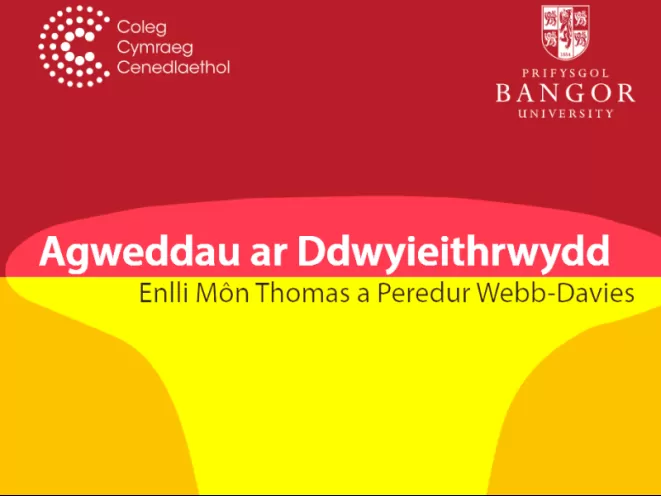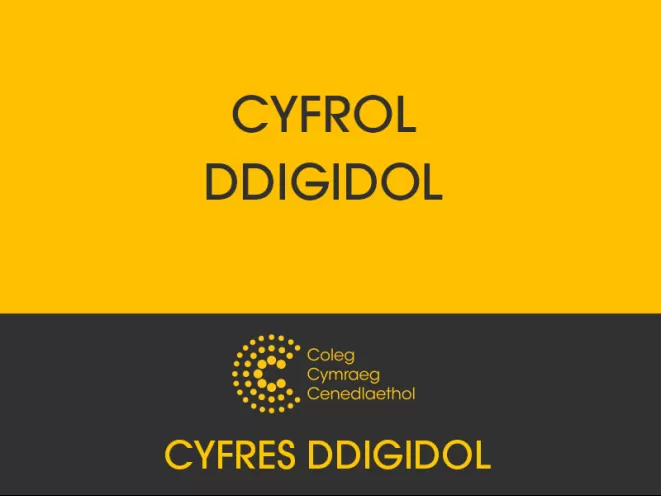Dyma fideo sy'n dangos sut i fynd i'r afael ag adfywio claf.
Adfywio cleifion: canllaw i nyrsys
Adolygiad Barnwrol
Cyfres o chwe darlith gan Manon George, Prifysgol Caerdydd, ar Adolygiad Barnwrol.
Agweddau ar Ddwyieithrwydd
E-lyfr newydd gan yr Athro Enlli Môn Thomas a Dr Peredur Webb-Davies o Brifysgol Bangor. Ac ystyried bod mwy o ieithoedd gwahanol nag o wledydd yn y byd, mae'n anochel bod ieithoedd yn dod i gysylltiad â'i gilydd mewn rhyw ffordd ac ar ryw adeg yn ystod eu bodolaeth. O ganlyniad, poblogaeth amlieithog ei naws yw'r rhan helaethaf o boblogaeth y byd. Er nad oes ffigyrau penodol (neu ddull casglu data digon ymarferol) yn nodi'r union ganran neu union nifer y siaradwyr uniaith a dwyieithog a geir, mae meddu ar ddwy neu fwy o ieithoedd yn ddarlun teg o'r 'norm' ieithyddol cyfredol ar gychwyn yr 21ain ganrif. O'r ychydig dros 6,000 o ieithoedd sy'n parhau i fodoli ledled y byd, prin bod unrhyw un wedi'i hynysu rhag pobloedd neu gymdeithasau ieithyddol eraill. Daw pob iaith bron i gysylltiad ag iaith arall, ond nid pawb sydd o'r farn fod hynny'n dda o beth! Bwriad y llyfr hwn yw eich cyflwyno i fyd y siaradwr dwyieithog, ac i herio nifer o fythau ynglÅ·n ag anfanteision - ac, yn wir, manteision - dwyieithrwydd. Y gobaith yw y bydd y darllenydd, o ddarllen y gyfrol hon, yn deall yn well natur ac anghenion unigolion sydd yn meddu ar sgiliau mewn dwy iaith.
Alan Llwyd yn trafod Cofiant Kate Roberts
Darlith gan Alan Llwyd ar Kate, ei gofiant i Kate Roberts. Recordiwyd y ddarlith yn Ysgol y Gymraeg, Prifysgol Bangor, ym mis Mawrth 2012. Cyllidwyd y digwyddiad drwy gyfrwng grant bach gan y Coleg Cymraeg Cenedlaethol.
Anawsterau Dysgu
Datblygwyd y modiwl a’r adnoddau gan Brifysgol Casnewydd a Phrifysgol Metropolitan Caerdydd i ymdrin yn uniongyrchol â dulliau addysgu a dysgu ar gyfer disgyblion sydd â dyslecsia, mewn ymgais i gynyddu gwybodaeth a dealltwriaeth addysgwyr o ddyslecsia.
Anufudd-dod Dinesig – Meredydd Evans
Darlith yn trafod amodau moesol gweithredu anghyfreithlon, neu anufudd-dod dinesig, dros yr iaith Gymraeg. Dyma Ddarlith Goffa J. R. Jones, 1993.
Ar Gwestiynau Rhyfel a Heddwch – E. T. John
Dyfyniadau o areithiau ac erthyglau gan E. T. John, Aelod Seneddol dwyrain Sir Ddinbych yn ystod y Rhyfel Byd Cyntaf, cenedlaetholwr Cymreig a heddychwr. Roedd yn aelod o'r Blaid Ryddfrydol hyd 1918, pan ymunodd â'r Blaid Lafur. Cyhoeddwyd gyntaf yn 1918.
Areithiau Eisteddfod Aberafan – J. R. Jones (gol.)
Casgliad o bedair araith gan J. R. Jones, Siôn Daniel, Emyr Llywelyn ac Alwyn D. Rees a draddodwyd yn Eisteddfod Genedlaethol Aberafan ym 1966 yn trafod ymgyrchu dros y Gymraeg a lle gweithredu anghyfreithlon yn dilyn ethol aelod seneddol cyntaf Plaid Cymru, Gwynfor Evans.
Edward Lhuyd annual lecture
The Edward Lhuyd Lecture is an annual presentation on various aspects of academic and contemporary life in Wales and the world. The presentations cover a wide variety of themes including geology, literature, ecology or history. The lecture is organized between the Coleg Cymaeg and the Learned Society of Wales. Note, there were no lectures in 2020 - 2022 due to Covid-19.
Cynhadledd ‘Boddi mewn Celfyddyd’: Gwaddol ’65
Hanner can mlynedd ar ôl boddi Tryweryn, trefnwyd cynhadledd i gasglu ynghyd a gwerthfawrogi’r gwaddol celfyddydol a ysbrydolwyd gan foddi’r cwm mewn cynhadledd deuddydd mewn lleoliad arbennig nid nepell o Dryweryn. Yn ystod y gynhadledd, traddodwyd darlithoedd gan Dafydd Iwan a Manon Eames, a chafwyd arddangosfa aml-gyfrwng unigryw yn dogfennu hanes y boddi, a’r cynnyrch celfyddydol a grëwyd yn ei sgil. Cafwyd hefyd gyfle i ymweld â Thryweryn a chlywed am brofiadau ac atgofion Aeron Prysor Jones am foddi’r cwm, yn ogystal â mwynhau detholiad o’r ddrama Porth y Byddar gan Manon Eames, o dan gyfarwyddyd Siwan Llynor. Noddwyd y gynhadledd gan y Coleg Cymraeg Cenedlaethol a Phrifysgol Bangor.
Deconvolution of the complex modulus in linear viscoelasticity
The relaxation spectrum of a viscoelastic material holds the key to describing its relaxation mechanisms at a molecular level. It also plays a fundamental role in accessing the molecular weight distribution, and in modelling the dynamics of complex uids. The relaxation spectrum cannot be measured directly, but it may be locally determined from experimental measurements of viscoelastic response at a macroscopic level. In particular, the relaxation spectrum is a continuous distribution of relaxation times which may be recovered, at least locally, from measurements of the complex modulus of the material. Although mathematical expressions for the continuous spectrum have been known for over a century, these were inaccessible to numerical implementation for decades, since they involve inverse operators which are not continuous, resulting in severe instability. Progress was made when regularization methods for approximating discrete line spectra were introduced some two decades ago. It was not until 2012, however, that Davies and Goulding proposed a method of wavelet regularization for recovering continuous spectra in a mathematically rigorous framework. This work was further re ned in 2016 by introducing a mathematical form of high-order derivative spectroscopy involving sequences of derivatives of dynamic moduli, termed Maclaurin sequences. In this article, a rigorous justi cation for the use of Maclaurin sequences is presented. Furthermore, a new sequence is presented, which is termed a wavelet correction sequence, achieving the same accuracy as Maclaurin sequences, but with a reduced order of differentiation.
Academi Cynhadledd Achos
Mae'r clipiau yma yn olrhain hanes cynhadledd achos er mwyn gwarchod plant. Mae’r clipiau yn cynnig enghraifft i fyfyrwyr o’r modd y cynhelir Cynhadledd Achos. Yn yr achos hwn, trafodir dau blentyn ifanc o’r enw Siân a Dylan. Mae Siân yn bump oed, a Dylan yn fabi deunaw mis oed. Pwrpas cynnal y Gynhadledd Achos yw i benderfynu a ddylai’r plant barhau ar y gofrestr amddiffyn plant ai peidio. Mae'r fideo wedi ei rannu mewn i 8 rhan. Dychmygol yw’r cymeriadau yn yr adnodd hwn, ond mae’r math yma o sefyllfa yn gyffredin iawn o fewn cyd-destun y Gynhadledd Achos.












